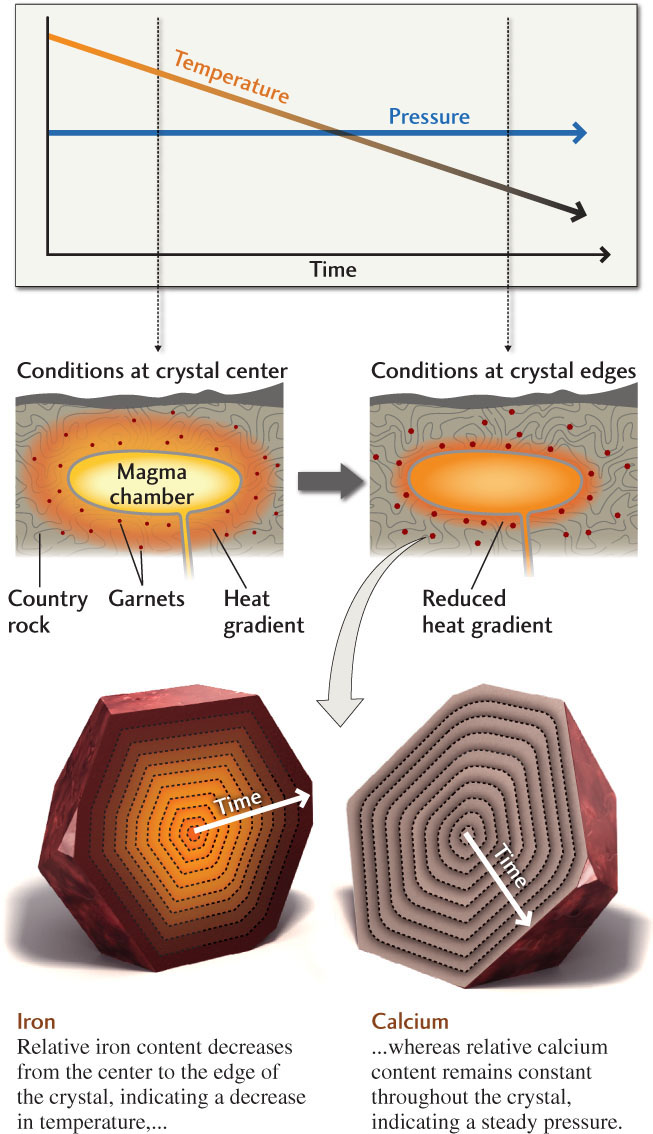Practicing Geology Exercise
How Do We Read Geologic History in Crystals?
What can a tiny crystal of garnet tell us about the history of the place where it was found? Knowing the plate tectonic setting in which a rock sample was formed tells us what other kinds of minerals might be found there. Geologists use variations in the chemical composition of garnet porphyroblasts to deduce the relative rates at which the rocks containing them were buried and then exhumed. These rates, in turn, reflect particular plate tectonic settings, as shown in Figure 6.13.
The chemical composition of a garnet porphyroblast generally varies progressively from its center to its edges (see Figure 6.12). This progression gives us a sense of change in pressure or temperature as a function of time: the center of the crystal records earlier conditions, and the edge of the crystal records later conditions. Changes in the calcium content of garnet track changes in pressure, whereas its iron content is more sensitive to temperature changes. We have noted that the increase in pressure over a given range of temperature values is much higher during subduction at ocean-continent convergence zones than it is during mountain building at continent-continent convergence zones. Conversely, a rock heated by an igneous intrusion experiences an increase in temperature, but little change in pressure.
By analyzing the chemical composition of garnet crystals, we can distinguish between these different metamorphic processes. To do so, we can compare changes in the abundance of the element of interest (calcium or iron) with the sum of changes in the abundances of all the elements that can vary in garnet: calcium (Ca), iron (Fe), magnesium (Mg), and manganese (Mn). Calculating the actual changes in pressure and temperature that a rock experienced during metamorphism requires additional data, including the composition of the complete mineral assemblage. Even without those details, however, it is possible to make some rough estimates.
168

The following data were obtained by measuring the number of atoms of four elements in the center and at the edge of a garnet porphyroblast:
| Element | Abundance at center | Abundance at edge |
|---|---|---|
| Ca | 0.30 | 0.30 |
| Fe | 2.25 | 1.98 |
| Mg | 0.20 | 0.52 |
| Mn | 0.25 | 0.20 |
We first calculate the relative abundances of calcium and iron at the center of the crystal using the following ratios:

Then we do the same for the relative abundances of calcium and iron at the edge:

Based on these data, what can you say about the metamorphic event that caused this garnet crystal to grow? Was the rock carried down into a subduction zone, or was it sitting next to an igneous intrusion?
The decrease in iron content from 0.75 to 0.66 from center to edge is not associated with any change in calcium content. This observation indicates that metamorphism resulted mainly from a change in temperature with no change in pressure. These conditions are more consistent with metamorphism near an igneous intrusion than they are with subduction.
BONUS PROBLEM: Assume that the same calculations showed that iron content was constant, but calcium content changed significantly from center to edge. Would this pattern be consistent with transport of the rocks into a subduction zone?